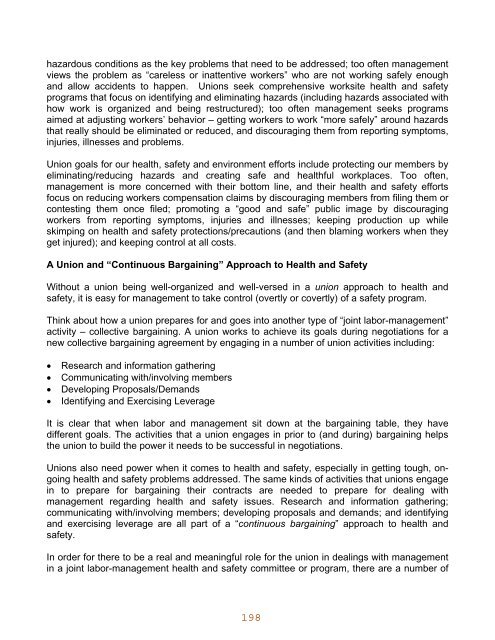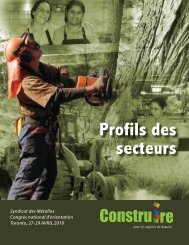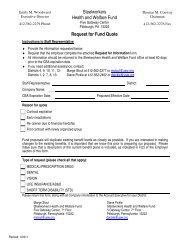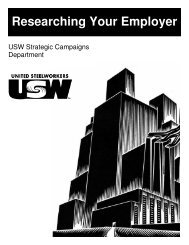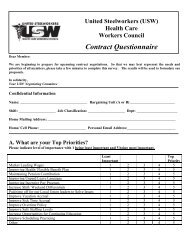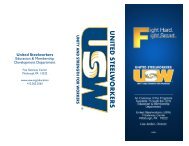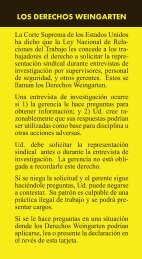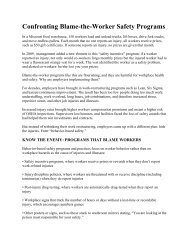Union Approach to Health and Safety: - United Steelworkers
Union Approach to Health and Safety: - United Steelworkers
Union Approach to Health and Safety: - United Steelworkers
Create successful ePaper yourself
Turn your PDF publications into a flip-book with our unique Google optimized e-Paper software.
hazardous conditions as the key problems that need <strong>to</strong> be addressed; <strong>to</strong>o often management<br />
views the problem as “careless or inattentive workers” who are not working safely enough<br />
<strong>and</strong> allow accidents <strong>to</strong> happen. <strong>Union</strong>s seek comprehensive worksite health <strong>and</strong> safety<br />
programs that focus on identifying <strong>and</strong> eliminating hazards (including hazards associated with<br />
how work is organized <strong>and</strong> being restructured); <strong>to</strong>o often management seeks programs<br />
aimed at adjusting workers’ behavior – getting workers <strong>to</strong> work “more safely” around hazards<br />
that really should be eliminated or reduced, <strong>and</strong> discouraging them from reporting symp<strong>to</strong>ms,<br />
injuries, illnesses <strong>and</strong> problems.<br />
<strong>Union</strong> goals for our health, safety <strong>and</strong> environment efforts include protecting our members by<br />
eliminating/reducing hazards <strong>and</strong> creating safe <strong>and</strong> healthful workplaces. Too often,<br />
management is more concerned with their bot<strong>to</strong>m line, <strong>and</strong> their health <strong>and</strong> safety efforts<br />
focus on reducing workers compensation claims by discouraging members from filing them or<br />
contesting them once filed; promoting a “good <strong>and</strong> safe” public image by discouraging<br />
workers from reporting symp<strong>to</strong>ms, injuries <strong>and</strong> illnesses; keeping production up while<br />
skimping on health <strong>and</strong> safety protections/precautions (<strong>and</strong> then blaming workers when they<br />
get injured); <strong>and</strong> keeping control at all costs.<br />
A <strong>Union</strong> <strong>and</strong> “Continuous Bargaining” <strong>Approach</strong> <strong>to</strong> <strong>Health</strong> <strong>and</strong> <strong>Safety</strong><br />
Without a union being well-organized <strong>and</strong> well-versed in a union approach <strong>to</strong> health <strong>and</strong><br />
safety, it is easy for management <strong>to</strong> take control (overtly or covertly) of a safety program.<br />
Think about how a union prepares for <strong>and</strong> goes in<strong>to</strong> another type of “joint labor-management”<br />
activity – collective bargaining. A union works <strong>to</strong> achieve its goals during negotiations for a<br />
new collective bargaining agreement by engaging in a number of union activities including:<br />
<br />
<br />
<br />
<br />
Research <strong>and</strong> information gathering<br />
Communicating with/involving members<br />
Developing Proposals/Dem<strong>and</strong>s<br />
Identifying <strong>and</strong> Exercising Leverage<br />
It is clear that when labor <strong>and</strong> management sit down at the bargaining table, they have<br />
different goals. The activities that a union engages in prior <strong>to</strong> (<strong>and</strong> during) bargaining helps<br />
the union <strong>to</strong> build the power it needs <strong>to</strong> be successful in negotiations.<br />
<strong>Union</strong>s also need power when it comes <strong>to</strong> health <strong>and</strong> safety, especially in getting <strong>to</strong>ugh, ongoing<br />
health <strong>and</strong> safety problems addressed. The same kinds of activities that unions engage<br />
in <strong>to</strong> prepare for bargaining their contracts are needed <strong>to</strong> prepare for dealing with<br />
management regarding health <strong>and</strong> safety issues. Research <strong>and</strong> information gathering;<br />
communicating with/involving members; developing proposals <strong>and</strong> dem<strong>and</strong>s; <strong>and</strong> identifying<br />
<strong>and</strong> exercising leverage are all part of a “continuous bargaining” approach <strong>to</strong> health <strong>and</strong><br />
safety.<br />
In order for there <strong>to</strong> be a real <strong>and</strong> meaningful role for the union in dealings with management<br />
in a joint labor-management health <strong>and</strong> safety committee or program, there are a number of


